Home / Tosylates And Mesylates
Alcohols, Epoxides and Ethers
Tosylates And Mesylates
Last updated: October 31st, 2025 |
All About Tosylates and Mesylates
- By themselves, alcohols are poor leaving groups since the hydroxide ion (HO-) is a strong base
- The OH group can be converted into a much better leaving group through conversion to a sulfonate group such as p-toluenesulfonyl (“tosyl”, abbreviated Ts) or methanesulfonyl (“mesyl”, abbreviated Ms)
- Installing these groups does not affect the stereochemistry of the alcohol
- The OTs and OMs groups can participate in substitution and elimination reactions.
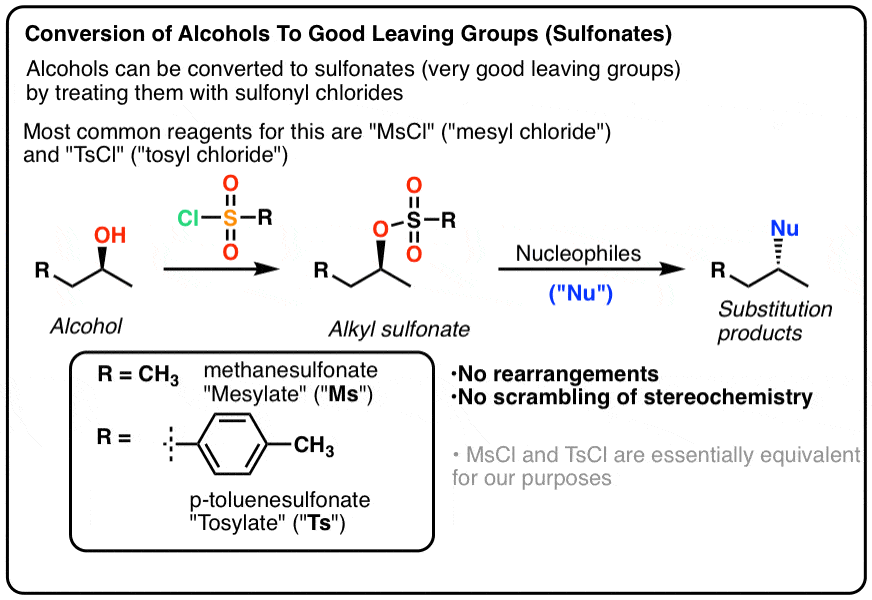
Table of Contents
- Making Alcohols Into Good Leaving Groups (Part 2)
- A Good Idea That Doesn’t Actually Work Well: Sulfate Leaving Groups
- Introducing “Tosylates” and “Mesylates”
- How Tosylates And Mesylates Are Made From Alcohols
- Four Specific Examples of Tosylates and Mesylates In Action
- Summary: Tosylates and Mesylates
- Notes
- Quiz Yourself!
- (Advanced) References and Further Reading
1. Making Alcohols Into Good Leaving Groups, Part 2
We’ve seen that alcohols are poor substrates for substitution reactions. The main problem is that the hydroxyl group is a strong base, and thus a poor leaving group.

In the last post we saw that we can convert alcohols into alkyl halides by adding strong hydrohalic acids (HCl, HBr, HI): the strong acid protonates R-OH to give R-OH2+ (with the better leaving group, H2O) and then substitution by the halide ion can occur.
In contrast to alcohols, alkyl halides are GREAT substrates for nucleophilic substitution reactions.
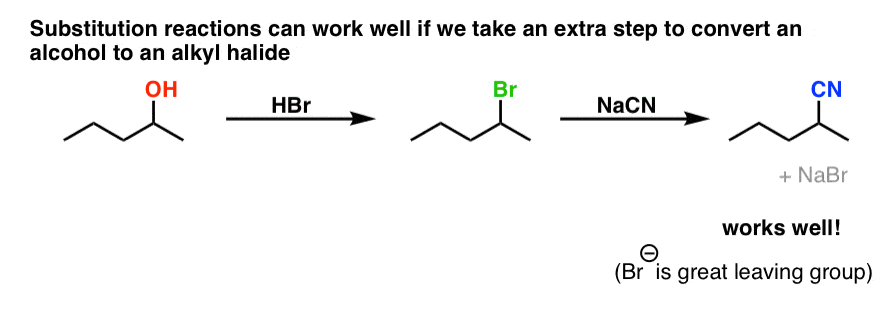
Unfortunately this doesn’t always work well. There are two main problems. First of all, on certain secondary alcohols the reaction proceeds through an SN1 pathway, which can lead to rearrangements. Secondly, in so doing, we can end up scrambling any stereocenters that are present. For instance if we start with one enantiomer in the reaction below, we end up with some racemization of the final product.
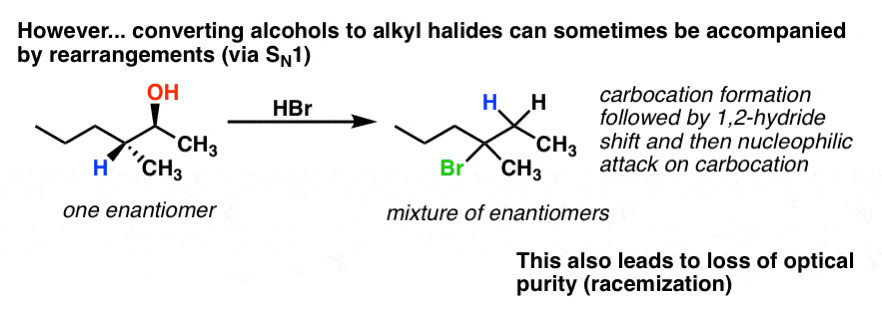
So is there some other way to convert alcohols into good leaving groups that doesn’t have these problems?
Sure thing!
2. One Good Idea (Which Doesn’t Actually Work That Well)
We all know that hydroxide (HO- ) is a strong base. But have we seen any examples of weak bases with a negative charge on the oxygen?
Yes! Sulfuric acid (H2SO4) is a very strong acid (pKa of about -3) and its conjugate base, HSO3O– , is therefore a weak base. This is due to two key factors – first of all, delocalization of charge on the other oxygens through resonance, and secondly, the inductive effect of those oxygens helping to redistribute the charge.
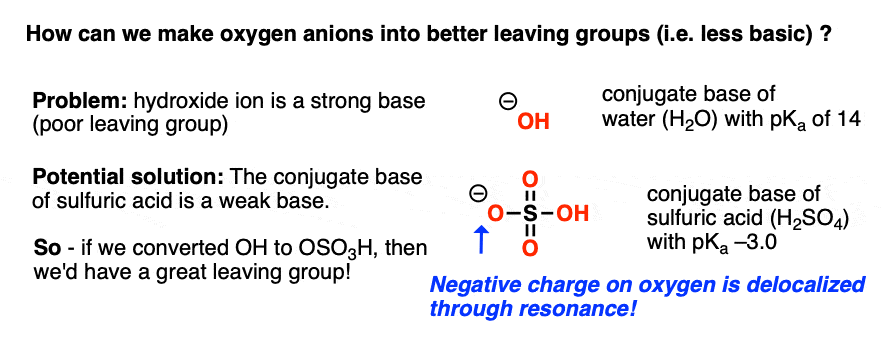
So in a perfect world, if we had some way of easily turning an alcohol (R-OH) into an alkyl hydrogen sulfate (R-OSO3H) then we’d have a nice way of making an alcohol into a good leaving group.
So how might this work in practice? Actually it doesn’t work very well!
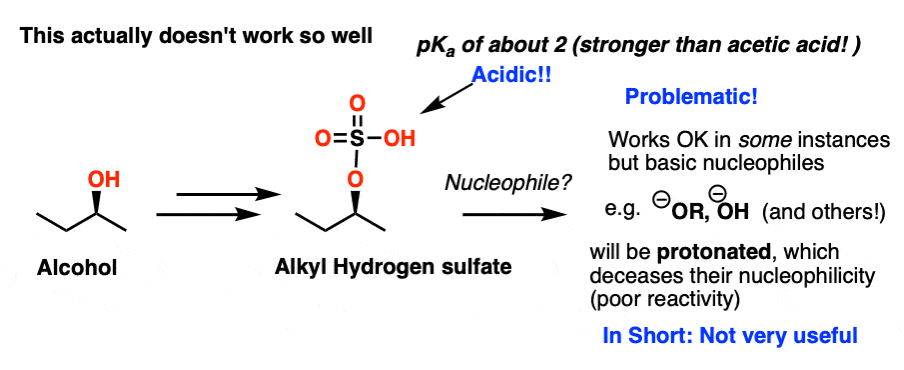
It’s not that –OSO3H is a poor leaving group (it’s a great leaving group). The problem is that many nucleophiles are quite basic (remember – the conjugate base is a better nucleophile) and the OSO3H still has a very acidic proton (that OH group has a pKa of about 2, making it a stronger acid than acetic acid).
The bottom line is that if we add a basic nucleophile, an acid base reaction will occur instead of our desired substitution reaction. The nucleophile will be protonated into its conjugate acid (less nucleophilic) and any substitution reactions will be considerably slower. Not ideal!
3. Introducing “Tosylates” and “Mesylates”
Is there some way around this? Sure! It’s just a matter of replacing that OH group on the sulfur by some kind of relatively inert organic group (R group) that doesn’t have an acidic proton.
If we swap in a methyl group (CH3) our leaving group would be –OSO2CH3, or “methanesulfonate” (commonly called, “mesylate” and abbreviated OMs. This has all the advantages of a great leaving group without the drawback of an acidic proton to react with nucleophiles.
Another popular option is using the conjugate base of p-toluenesulfonic acid, (“p-toluenesulfonate”) commonly called “tosylate” and abbreviated OTs.
These groups have essentially identical leaving group ability and for our purposes are interchangeable. Some textbooks tend to use Ts more, others use Ms. It doesn’t really matter for us at this stage: they both work.
[A third option, less commonly seen in introductory courses, is the “triflate” (Tf) group, which replaces the three hydrogens on methanesulfonate with three fluorines. The conjugate acid, trifluoromethanesulfonic acid, is among the more acidic species known (pKa of -13!) and for this reason, triflate is a really “hot” leaving group when attached to alkyl groups: it likes to leave of its own accord! It’s more commonly used on aromatic alcohols and other species that don’t form carbocations as easily]
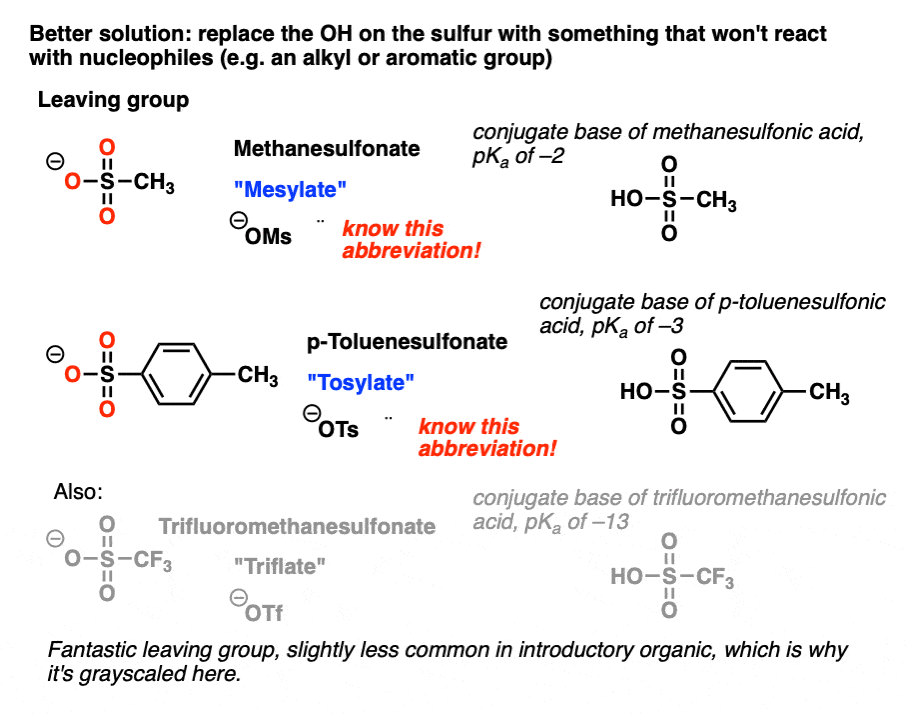
4. How Do We Make Mesylates And Tosylates From Alcohols?
So how can we apply this? If we have an alcohol, how do we turn that hydroxyl into a tosyl or mesyl group?
It’s relatively straightforward actually. We use “mesyl chloride” (MsCl) or “tosyl chloride” (TsCl), and the neutral alcohol performs a substitution reaction on sulfur, leading to formation of O-S and breakage of S-Cl. Then, deprotonation of the charged alcohol leads to the neutral mesylate or tosylate.
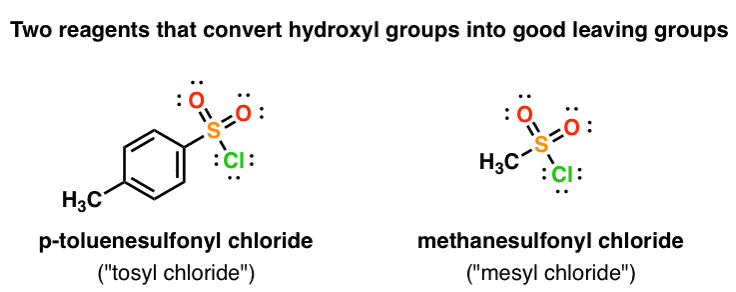
Note that the stereochemistry is completely unchanged here (unlike if we had used H-Cl, for example). Watch out for this – stereochemistry is often tested on exams!
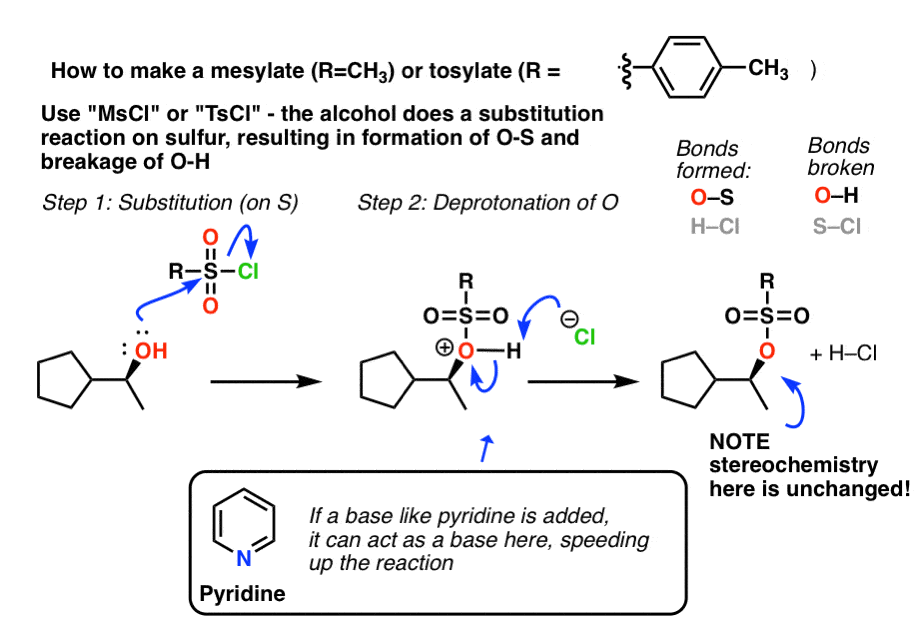
[By the way – sometimes you might see that an organic base such as pyridine is also added, which helps the process along by removing HCl as it is formed. ]
5. Four Specific Examples Of Tosylates and Mesylates In Action
Let’s finish up by seeing some specific examples of Ts and Ms in action. As they contain a good leaving group, alkyl tosylates or mesylates can perform all of the substitution and elimination reactions of alkyl halides. A few examples are shown below. Get familiar with MsCl and TsCl in both their abbreviated and expanded (i.e. “drawn-out”) forms.
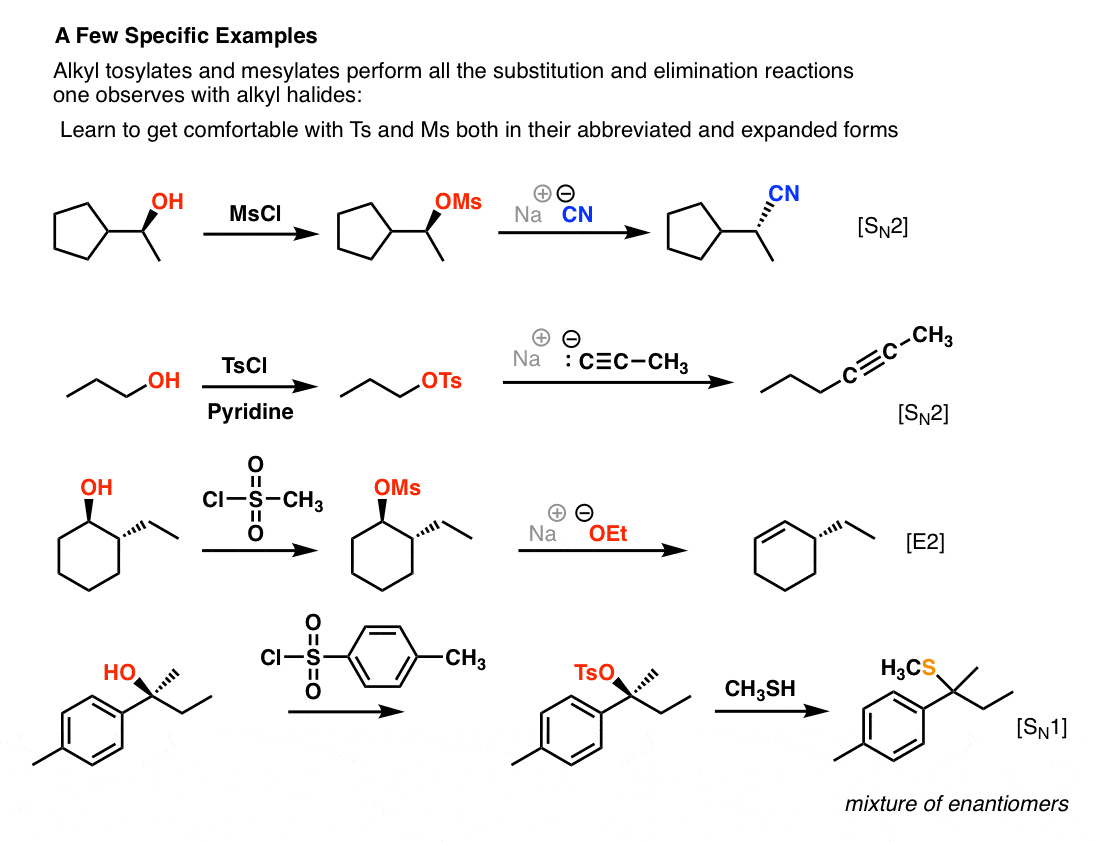
6. Summary: Tosylates And Mesylates
In the last two posts we’ve seen how useful it is to be able to convert alcohols to good leaving groups. In our next post we’ll cover one last method to do this that involves some new reagents, PBr3 (including other phosphorus halides) and SOCl2.
Next Post – PBr3 And SOCl2
Notes
Related Articles
Quiz Yourself!
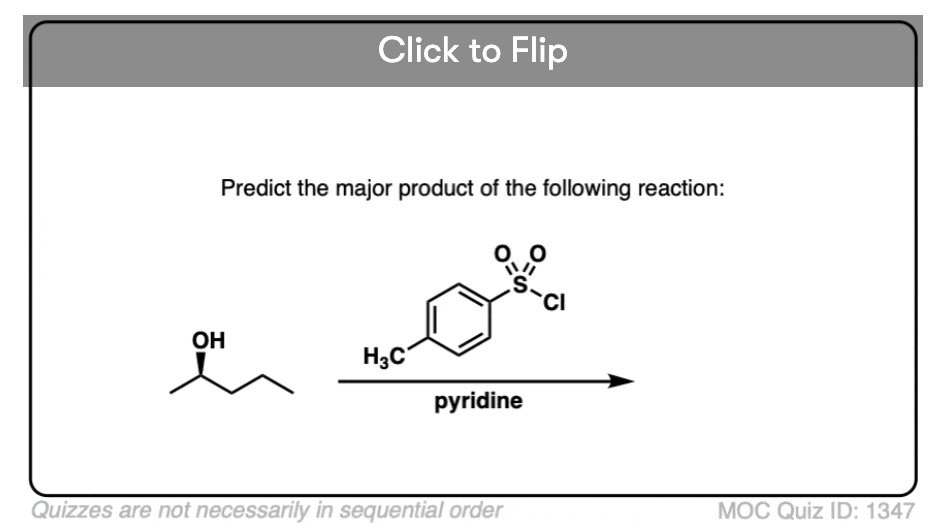
Become a MOC member to see the clickable quiz with answers on the back.

Become a MOC member to see the clickable quiz with answers on the back.
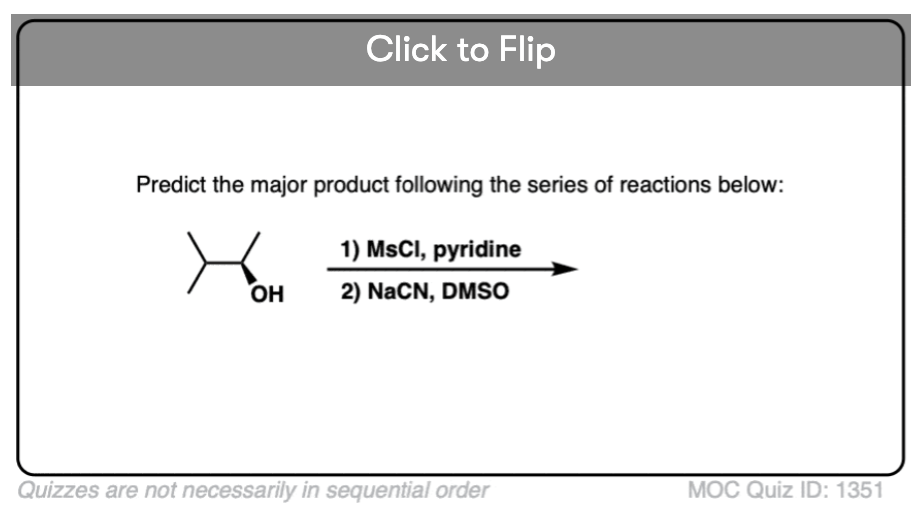
Become a MOC member to see the clickable quiz with answers on the back.
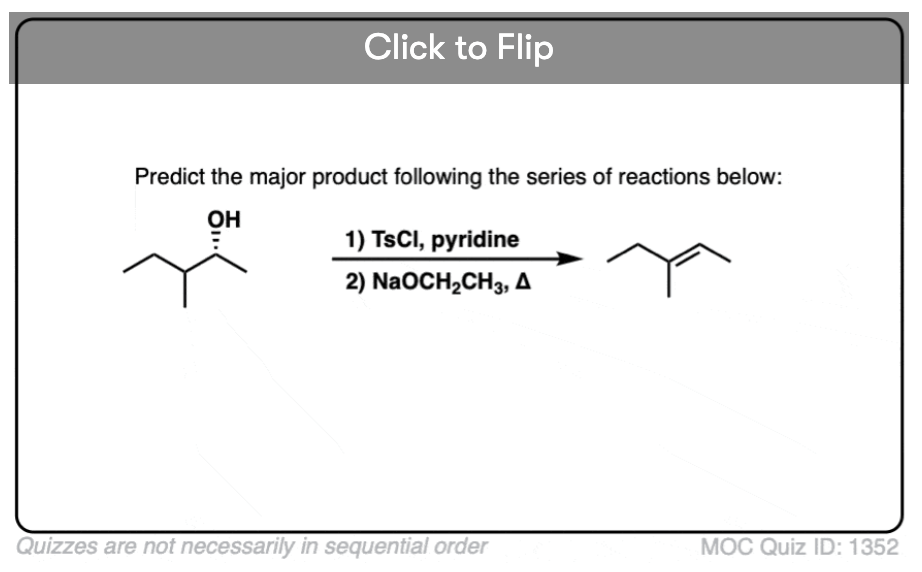
Become a MOC member to see the clickable quiz with answers on the back.
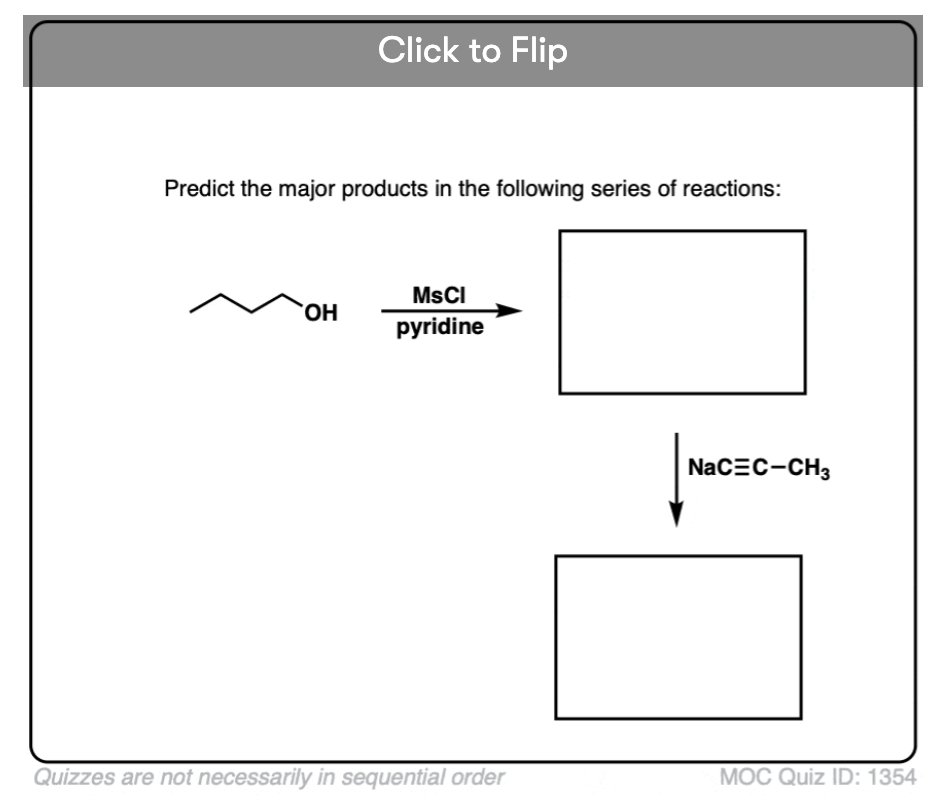
Become a MOC member to see the clickable quiz with answers on the back.
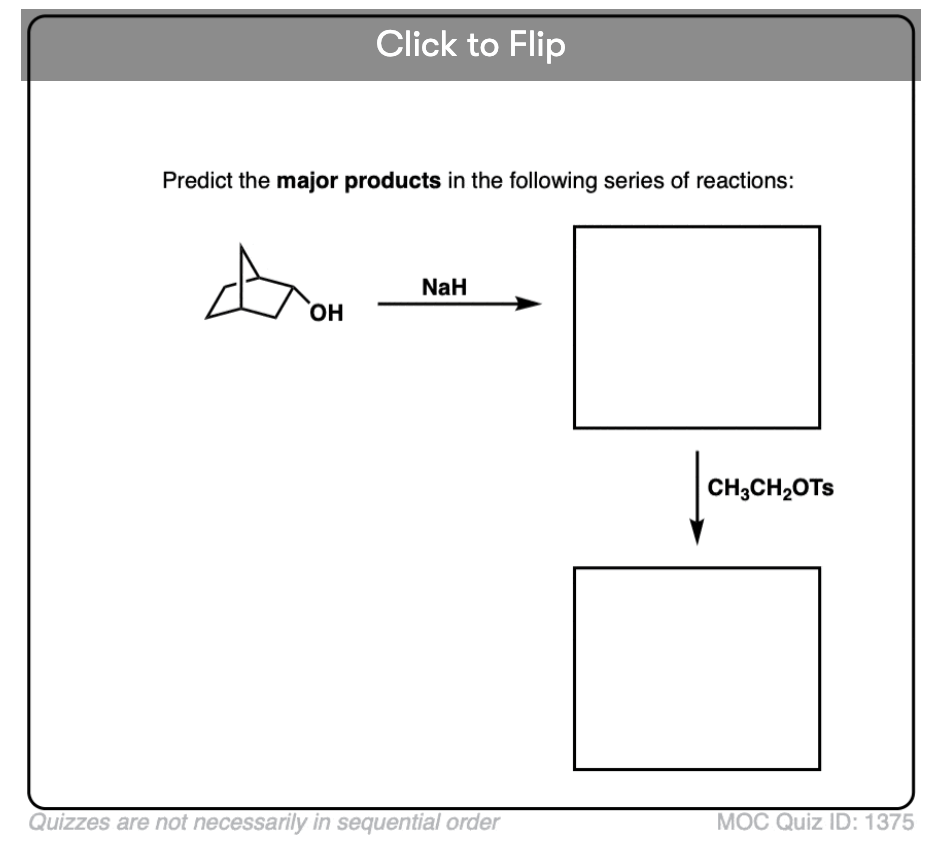
Become a MOC member to see the clickable quiz with answers on the back.
(Advanced) References Further Reading
- ON ESTERS OF p-TOLUENESULFONIC ACID
STUART TIPSON
The Journal of Organic Chemistry, 1944, 09 (3), 235-241
DOI: 10.1021/jo01185a005
Early reference on tosylation by Stuart Tipson, who was at the Mellon Institute of Industrial Research (now Carnegie-Mellon University). - The tosylation of alcohols
George W. Kabalka, Manju Varma, Rajender S. Varma, Prem C. Srivastava, and Furn F. Knapp Jr.
The Journal of Organic Chemistry, 1986, 51 (12), 2386-2388
DOI: 10.1021/jo00362a044
This paper describes an improved procedure for tosylation of alcohols.Besides the p-toluenesulfonyl group, other sulfonate esters can be prepared as leaving groups from alcohols (e.g. mesylate, brosylate, triflate, trifluoroacetate, nonaflate, etc.). Two papers describing mesylate ester synthesis are described below: - Kinetic and spectroscopic characterisation of highly reactive methanesulfonates. Leaving group effects for solvolyses and comments on geminal electronic effects influencing SN1 reactivity
William Bentley, Manfred Christl, Ralf Kemmer, Gareth Llewellyn and John E. Oakley
J. Chem. Soc., Perkin Trans. 2, 1994, 2531-2538
DOI: 10.1039/P29940002531 - Palladium-catalyzed Buchwald-Hartwig Amination and Suzuki-Miyaura Cross-coupling Reaction of Aryl Mesylates
Shun Man Wong, Pui Ying Choy, On Ying Yuen, Chau Ming So, and Fuk Yee Kwong
Synth.2015, 92, 195-212
DOI: 10.15227/orgsyn.092.0195
The first step in this procedure is the mesylation of p-t-butylphenol. - Synthesis of some novel trifluoromethanesulfonates and their reactions with alcohol
Charles D. Beard, Kurt Baum, and Vytautas Grakauskas
The Journal of Organic Chemistry, 1973, 38 (21), 3673-3677
DOI: 10.1021/jo00961a003
Triflate (-SO2CF3) esters are much more reactive than tosylates or mesylates, since the triflate anion is a superb leaving group. This paper describes the synthesis of various triflate esters but gives no mention for safety considerations – these are potent alkylating agents and are highly carcinogenic.
00 General Chemistry Review
01 Bonding, Structure, and Resonance
- How Do We Know Methane (CH4) Is Tetrahedral?
- Hybrid Orbitals and Hybridization
- How To Determine Hybridization: A Shortcut
- Orbital Hybridization And Bond Strengths
- Sigma bonds come in six varieties: Pi bonds come in one
- Dipole Moments and Dipoles
- A Key Skill: How to Calculate Formal Charge
- The Four Intermolecular Forces and How They Affect Boiling Points
- 3 Trends That Affect Boiling Points
- How To Use Electronegativity To Determine Electron Density (and why NOT to trust formal charge)
- Introduction to Resonance
- How To Use Curved Arrows To Interchange Resonance Forms
- Evaluating Resonance Forms (1) - The Rule of Least Charges
- How To Find The Best Resonance Structure By Applying Electronegativity
- Evaluating Resonance Structures With Negative Charges
- Evaluating Resonance Structures With Positive Charge
- Exploring Resonance: Pi-Donation
- Exploring Resonance: Pi-acceptors
- In Summary: Evaluating Resonance Structures
- Drawing Resonance Structures: 3 Common Mistakes To Avoid
- How to apply electronegativity and resonance to understand reactivity
- Bond Hybridization Practice
- Structure and Bonding Practice Quizzes
- Resonance Structures Practice
02 Acid Base Reactions
- Introduction to Acid-Base Reactions
- Acid Base Reactions In Organic Chemistry
- The Stronger The Acid, The Weaker The Conjugate Base
- Walkthrough of Acid-Base Reactions (3) - Acidity Trends
- Five Key Factors That Influence Acidity
- Acid-Base Reactions: Introducing Ka and pKa
- How to Use a pKa Table
- The pKa Table Is Your Friend
- A Handy Rule of Thumb for Acid-Base Reactions
- Acid Base Reactions Are Fast
- pKa Values Span 60 Orders Of Magnitude
- How Protonation and Deprotonation Affect Reactivity
- Acid Base Practice Problems
03 Alkanes and Nomenclature
- Meet the (Most Important) Functional Groups
- Condensed Formulas: Deciphering What the Brackets Mean
- Hidden Hydrogens, Hidden Lone Pairs, Hidden Counterions
- Don't Be Futyl, Learn The Butyls
- Primary, Secondary, Tertiary, Quaternary In Organic Chemistry
- Branching, and Its Affect On Melting and Boiling Points
- The Many, Many Ways of Drawing Butane
- Wedge And Dash Convention For Tetrahedral Carbon
- Common Mistakes in Organic Chemistry: Pentavalent Carbon
- Table of Functional Group Priorities for Nomenclature
- Summary Sheet - Alkane Nomenclature
- Organic Chemistry IUPAC Nomenclature Demystified With A Simple Puzzle Piece Approach
- Boiling Point Quizzes
- Organic Chemistry Nomenclature Quizzes
04 Conformations and Cycloalkanes
- Staggered vs Eclipsed Conformations of Ethane
- Conformational Isomers of Propane
- Newman Projection of Butane (and Gauche Conformation)
- Introduction to Cycloalkanes
- Geometric Isomers In Small Rings: Cis And Trans Cycloalkanes
- Calculation of Ring Strain In Cycloalkanes
- Cycloalkanes - Ring Strain In Cyclopropane And Cyclobutane
- Cyclohexane Conformations
- Cyclohexane Chair Conformation: An Aerial Tour
- How To Draw The Cyclohexane Chair Conformation
- The Cyclohexane Chair Flip
- The Cyclohexane Chair Flip - Energy Diagram
- Substituted Cyclohexanes - Axial vs Equatorial
- Ranking The Bulkiness Of Substituents On Cyclohexanes: "A-Values"
- Cyclohexane Chair Conformation Stability: Which One Is Lower Energy?
- Fused Rings - Cis-Decalin and Trans-Decalin
- Naming Bicyclic Compounds - Fused, Bridged, and Spiro
- Bredt's Rule (And Summary of Cycloalkanes)
- Newman Projection Practice
- Cycloalkanes Practice Problems
05 A Primer On Organic Reactions
- The Most Important Question To Ask When Learning a New Reaction
- Curved Arrows (for reactions)
- Nucleophiles and Electrophiles
- The Three Classes of Nucleophiles
- Nucleophilicity vs. Basicity
- What Makes A Good Nucleophile?
- What Makes A Good Leaving Group?
- 3 Factors That Stabilize Carbocations
- Equilibrium and Energy Relationships
- 7 Factors that stabilize negative charge in organic chemistry
- 7 Factors That Stabilize Positive Charge in Organic Chemistry
- What's a Transition State?
- Hammond's Postulate
- Learning Organic Chemistry Reactions: A Checklist (PDF)
06 Free Radical Reactions
- Free Radical Reactions
- 3 Factors That Stabilize Free Radicals
- Bond Strengths And Radical Stability
- Free Radical Initiation: Why Is "Light" Or "Heat" Required?
- Initiation, Propagation, Termination
- Monochlorination Products Of Propane, Pentane, And Other Alkanes
- Selectivity In Free Radical Reactions
- Selectivity in Free Radical Reactions: Bromination vs. Chlorination
- Halogenation At Tiffany's
- Allylic Bromination
- Bonus Topic: Allylic Rearrangements
- In Summary: Free Radicals
- Synthesis (2) - Reactions of Alkanes
- Free Radicals Practice Quizzes
07 Stereochemistry and Chirality
- Types of Isomers: Constitutional Isomers, Stereoisomers, Enantiomers, and Diastereomers
- How To Draw The Enantiomer Of A Chiral Molecule
- How To Draw A Bond Rotation
- Introduction to Assigning (R) and (S): The Cahn-Ingold-Prelog Rules
- Assigning Cahn-Ingold-Prelog (CIP) Priorities (2) - The Method of Dots
- Enantiomers vs Diastereomers vs The Same? Two Methods For Solving Problems
- Assigning R/S To Newman Projections (And Converting Newman To Line Diagrams)
- How To Determine R and S Configurations On A Fischer Projection
- The Meso Trap
- Optical Rotation, Optical Activity, and Specific Rotation
- Optical Purity and Enantiomeric Excess
- What's a Racemic Mixture?
- Chiral Allenes And Chiral Axes
- Stereochemistry Practice Problems and Quizzes
08 Substitution Reactions
- Nucleophilic Substitution Reactions - Introduction
- Two Types of Nucleophilic Substitution Reactions
- The SN2 Mechanism
- Why the SN2 Reaction Is Powerful
- The SN1 Mechanism
- The Conjugate Acid Is A Better Leaving Group
- Comparing the SN1 and SN2 Reactions
- Polar Protic? Polar Aprotic? Nonpolar? All About Solvents
- Steric Hindrance is Like a Fat Goalie
- Common Blind Spot: Intramolecular Reactions
- Substitution Practice - SN1
- Substitution Practice - SN2
09 Elimination Reactions
- Elimination Reactions (1): Introduction And The Key Pattern
- Elimination Reactions (2): The Zaitsev Rule
- Elimination Reactions Are Favored By Heat
- Two Elimination Reaction Patterns
- The E1 Reaction
- The E2 Mechanism
- E1 vs E2: Comparing the E1 and E2 Reactions
- Antiperiplanar Relationships: The E2 Reaction and Cyclohexane Rings
- Bulky Bases in Elimination Reactions
- Comparing the E1 vs SN1 Reactions
- Elimination (E1) Reactions With Rearrangements
- E1cB - Elimination (Unimolecular) Conjugate Base
- Elimination (E1) Practice Problems And Solutions
- Elimination (E2) Practice Problems and Solutions
10 Rearrangements
11 SN1/SN2/E1/E2 Decision
- Identifying Where Substitution and Elimination Reactions Happen
- Deciding SN1/SN2/E1/E2 (1) - The Substrate
- Deciding SN1/SN2/E1/E2 (2) - The Nucleophile/Base
- SN1 vs E1 and SN2 vs E2 : The Temperature
- Deciding SN1/SN2/E1/E2 - The Solvent
- Wrapup: The Key Factors For Determining SN1/SN2/E1/E2
- Alkyl Halide Reaction Map And Summary
- SN1 SN2 E1 E2 Practice Problems
12 Alkene Reactions
- E and Z Notation For Alkenes (+ Cis/Trans)
- Alkene Stability
- Alkene Addition Reactions: "Regioselectivity" and "Stereoselectivity" (Syn/Anti)
- Stereoselective and Stereospecific Reactions
- Hydrohalogenation of Alkenes and Markovnikov's Rule
- Hydration of Alkenes With Aqueous Acid
- Rearrangements in Alkene Addition Reactions
- Halogenation of Alkenes and Halohydrin Formation
- Oxymercuration Demercuration of Alkenes
- Hydroboration Oxidation of Alkenes
- m-CPBA (meta-chloroperoxybenzoic acid)
- OsO4 (Osmium Tetroxide) for Dihydroxylation of Alkenes
- Palladium on Carbon (Pd/C) for Catalytic Hydrogenation of Alkenes
- Cyclopropanation of Alkenes
- A Fourth Alkene Addition Pattern - Free Radical Addition
- Alkene Reactions: Ozonolysis
- Oxidative Cleavage of Vicinal Diols With NaIO4 and Pb(OAc)4
- Summary: Three Key Families Of Alkene Reaction Mechanisms
- Synthesis (4) - Alkene Reaction Map, Including Alkyl Halide Reactions
- Alkene Reactions Practice Problems
13 Alkyne Reactions
- Acetylides from Alkynes, And Substitution Reactions of Acetylides
- Partial Reduction of Alkynes With Lindlar's Catalyst
- Partial Reduction of Alkynes With Na/NH3 To Obtain Trans Alkenes
- Alkyne Hydroboration With "R2BH"
- Hydration and Oxymercuration of Alkynes
- Hydrohalogenation of Alkynes
- Alkyne Halogenation: Bromination and Chlorination of Alkynes
- Oxidation of Alkynes With O3 and KMnO4
- Alkenes To Alkynes Via Halogenation And Elimination Reactions
- Alkynes Are A Blank Canvas
- Synthesis (5) - Reactions of Alkynes
- Alkyne Reactions Practice Problems With Answers
14 Alcohols, Epoxides and Ethers
- Alcohols - Nomenclature and Properties
- Alcohols Can Act As Acids Or Bases (And Why It Matters)
- Alcohols - Acidity and Basicity
- The Williamson Ether Synthesis
- Ethers From Alkenes, Tertiary Alkyl Halides and Alkoxymercuration
- Alcohols To Ethers via Acid Catalysis
- Cleavage Of Ethers With Acid
- Epoxides - The Outlier Of The Ether Family
- Opening of Epoxides With Acid
- Epoxide Ring Opening With Base
- Making Alkyl Halides From Alcohols
- Tosylates And Mesylates
- PBr3 and SOCl2
- Elimination Reactions of Alcohols
- Elimination of Alcohols To Alkenes With POCl3
- Alcohol Oxidation: "Strong" and "Weak" Oxidants
- Demystifying The Mechanisms of Alcohol Oxidations
- Protecting Groups For Alcohols
- Thiols And Thioethers
- Calculating the oxidation state of a carbon
- Oxidation and Reduction in Organic Chemistry
- Oxidation Ladders
- SOCl2 Mechanism For Alcohols To Alkyl Halides: SN2 versus SNi
- Alcohol Reactions Roadmap (PDF)
- Alcohol Reaction Practice Problems
- Epoxide Reaction Quizzes
- Oxidation and Reduction Practice Quizzes
15 Organometallics
- What's An Organometallic?
- Formation of Grignard and Organolithium Reagents
- Organometallics Are Strong Bases
- Reactions of Grignard Reagents
- Protecting Groups In Grignard Reactions
- Synthesis Problems Involving Grignard Reagents
- Grignard Reactions And Synthesis (2)
- Organocuprates (Gilman Reagents): How They're Made
- Gilman Reagents (Organocuprates): What They're Used For
- The Heck, Suzuki, and Olefin Metathesis Reactions (And Why They Don't Belong In Most Introductory Organic Chemistry Courses)
- Reaction Map: Reactions of Organometallics
- Grignard Practice Problems
16 Spectroscopy
- Degrees of Unsaturation (or IHD, Index of Hydrogen Deficiency)
- Conjugation And Color (+ How Bleach Works)
- Introduction To UV-Vis Spectroscopy
- UV-Vis Spectroscopy: Absorbance of Carbonyls
- UV-Vis Spectroscopy: Practice Questions
- Bond Vibrations, Infrared Spectroscopy, and the "Ball and Spring" Model
- Infrared (IR) Spectroscopy: A Quick Primer On Interpreting Spectra
- IR Spectroscopy: 4 Practice Problems
- 1H NMR: How Many Signals?
- Homotopic, Enantiotopic, Diastereotopic
- Diastereotopic Protons in 1H NMR Spectroscopy: Examples
- 13-C NMR - How Many Signals
- Liquid Gold: Pheromones In Doe Urine
- Natural Product Isolation (1) - Extraction
- Natural Product Isolation (2) - Purification Techniques, An Overview
- Structure Determination Case Study: Deer Tarsal Gland Pheromone
17 Dienes and MO Theory
- What To Expect In Organic Chemistry 2
- Are these molecules conjugated?
- Conjugation And Resonance In Organic Chemistry
- Bonding And Antibonding Pi Orbitals
- Molecular Orbitals of The Allyl Cation, Allyl Radical, and Allyl Anion
- Pi Molecular Orbitals of Butadiene
- Reactions of Dienes: 1,2 and 1,4 Addition
- Thermodynamic and Kinetic Products
- More On 1,2 and 1,4 Additions To Dienes
- s-cis and s-trans
- The Diels-Alder Reaction
- Cyclic Dienes and Dienophiles in the Diels-Alder Reaction
- Stereochemistry of the Diels-Alder Reaction
- Exo vs Endo Products In The Diels Alder: How To Tell Them Apart
- HOMO and LUMO In the Diels Alder Reaction
- Why Are Endo vs Exo Products Favored in the Diels-Alder Reaction?
- Diels-Alder Reaction: Kinetic and Thermodynamic Control
- The Retro Diels-Alder Reaction
- The Intramolecular Diels Alder Reaction
- Regiochemistry In The Diels-Alder Reaction
- The Cope and Claisen Rearrangements
- Electrocyclic Reactions
- Electrocyclic Ring Opening And Closure (2) - Six (or Eight) Pi Electrons
- Diels Alder Practice Problems
- Molecular Orbital Theory Practice
18 Aromaticity
- Introduction To Aromaticity
- Rules For Aromaticity
- Huckel's Rule: What Does 4n+2 Mean?
- Aromatic, Non-Aromatic, or Antiaromatic? Some Practice Problems
- Antiaromatic Compounds and Antiaromaticity
- The Pi Molecular Orbitals of Benzene
- The Pi Molecular Orbitals of Cyclobutadiene
- Frost Circles
- Aromaticity Practice Quizzes
19 Reactions of Aromatic Molecules
- Electrophilic Aromatic Substitution: Introduction
- Activating and Deactivating Groups In Electrophilic Aromatic Substitution
- Electrophilic Aromatic Substitution - The Mechanism
- Ortho-, Para- and Meta- Directors in Electrophilic Aromatic Substitution
- Understanding Ortho, Para, and Meta Directors
- Why are halogens ortho- para- directors?
- Disubstituted Benzenes: The Strongest Electron-Donor "Wins"
- Electrophilic Aromatic Substitutions (1) - Halogenation of Benzene
- Electrophilic Aromatic Substitutions (2) - Nitration and Sulfonation
- EAS Reactions (3) - Friedel-Crafts Acylation and Friedel-Crafts Alkylation
- Intramolecular Friedel-Crafts Reactions
- Nucleophilic Aromatic Substitution (NAS)
- Nucleophilic Aromatic Substitution (2) - The Benzyne Mechanism
- Reactions on the "Benzylic" Carbon: Bromination And Oxidation
- The Wolff-Kishner, Clemmensen, And Other Carbonyl Reductions
- More Reactions on the Aromatic Sidechain: Reduction of Nitro Groups and the Baeyer Villiger
- Aromatic Synthesis (1) - "Order Of Operations"
- Synthesis of Benzene Derivatives (2) - Polarity Reversal
- Aromatic Synthesis (3) - Sulfonyl Blocking Groups
- Birch Reduction
- Synthesis (7): Reaction Map of Benzene and Related Aromatic Compounds
- Aromatic Reactions and Synthesis Practice
- Electrophilic Aromatic Substitution Practice Problems
20 Aldehydes and Ketones
- What's The Alpha Carbon In Carbonyl Compounds?
- Nucleophilic Addition To Carbonyls
- Aldehydes and Ketones: 14 Reactions With The Same Mechanism
- Sodium Borohydride (NaBH4) Reduction of Aldehydes and Ketones
- Grignard Reagents For Addition To Aldehydes and Ketones
- Wittig Reaction
- Hydrates, Hemiacetals, and Acetals
- Imines - Properties, Formation, Reactions, and Mechanisms
- All About Enamines
- Breaking Down Carbonyl Reaction Mechanisms: Reactions of Anionic Nucleophiles (Part 2)
- Aldehydes Ketones Reaction Practice
21 Carboxylic Acid Derivatives
- Nucleophilic Acyl Substitution (With Negatively Charged Nucleophiles)
- Addition-Elimination Mechanisms With Neutral Nucleophiles (Including Acid Catalysis)
- Basic Hydrolysis of Esters - Saponification
- Transesterification
- Proton Transfer
- Fischer Esterification - Carboxylic Acid to Ester Under Acidic Conditions
- Lithium Aluminum Hydride (LiAlH4) For Reduction of Carboxylic Acid Derivatives
- LiAlH[Ot-Bu]3 For The Reduction of Acid Halides To Aldehydes
- Di-isobutyl Aluminum Hydride (DIBAL) For The Partial Reduction of Esters and Nitriles
- Amide Hydrolysis
- Thionyl Chloride (SOCl2) And Conversion of Carboxylic Acids to Acid Halides
- Diazomethane (CH2N2)
- Carbonyl Chemistry: Learn Six Mechanisms For the Price Of One
- Making Music With Mechanisms (PADPED)
- Carboxylic Acid Derivatives Practice Questions
22 Enols and Enolates
- Keto-Enol Tautomerism
- Enolates - Formation, Stability, and Simple Reactions
- Kinetic Versus Thermodynamic Enolates
- Aldol Addition and Condensation Reactions
- Reactions of Enols - Acid-Catalyzed Aldol, Halogenation, and Mannich Reactions
- Claisen Condensation and Dieckmann Condensation
- Decarboxylation
- The Malonic Ester and Acetoacetic Ester Synthesis
- The Michael Addition Reaction and Conjugate Addition
- The Robinson Annulation
- Haloform Reaction
- The Hell–Volhard–Zelinsky Reaction
- Enols and Enolates Practice Quizzes
23 Amines
- The Amide Functional Group: Properties, Synthesis, and Nomenclature
- Basicity of Amines And pKaH
- 5 Key Basicity Trends of Amines
- The Mesomeric Effect And Aromatic Amines
- Nucleophilicity of Amines
- Alkylation of Amines (Sucks!)
- Reductive Amination
- The Gabriel Synthesis
- Some Reactions of Azides
- The Hofmann Elimination
- The Hofmann and Curtius Rearrangements
- The Cope Elimination
- Protecting Groups for Amines - Carbamates
- The Strecker Synthesis of Amino Acids
- Introduction to Peptide Synthesis
- Reactions of Diazonium Salts: Sandmeyer and Related Reactions
- Amine Practice Questions
24 Carbohydrates
- D and L Notation For Sugars
- Pyranoses and Furanoses: Ring-Chain Tautomerism In Sugars
- What is Mutarotation?
- Reducing Sugars
- The Big Damn Post Of Carbohydrate-Related Chemistry Definitions
- The Haworth Projection
- Converting a Fischer Projection To A Haworth (And Vice Versa)
- Reactions of Sugars: Glycosylation and Protection
- The Ruff Degradation and Kiliani-Fischer Synthesis
- Isoelectric Points of Amino Acids (and How To Calculate Them)
- Carbohydrates Practice
- Amino Acid Quizzes
25 Fun and Miscellaneous
- A Gallery of Some Interesting Molecules From Nature
- Screw Organic Chemistry, I'm Just Going To Write About Cats
- On Cats, Part 1: Conformations and Configurations
- On Cats, Part 2: Cat Line Diagrams
- On Cats, Part 4: Enantiocats
- On Cats, Part 6: Stereocenters
- Organic Chemistry Is Shit
- The Organic Chemistry Behind "The Pill"
- Maybe they should call them, "Formal Wins" ?
- Why Do Organic Chemists Use Kilocalories?
- The Principle of Least Effort
- Organic Chemistry GIFS - Resonance Forms
- Reproducibility In Organic Chemistry
- What Holds The Nucleus Together?
- How Reactions Are Like Music
- Organic Chemistry and the New MCAT
26 Organic Chemistry Tips and Tricks
- Common Mistakes: Formal Charges Can Mislead
- Partial Charges Give Clues About Electron Flow
- Draw The Ugly Version First
- Organic Chemistry Study Tips: Learn the Trends
- The 8 Types of Arrows In Organic Chemistry, Explained
- Top 10 Skills To Master Before An Organic Chemistry 2 Final
- Common Mistakes with Carbonyls: Carboxylic Acids... Are Acids!
- Planning Organic Synthesis With "Reaction Maps"
- Alkene Addition Pattern #1: The "Carbocation Pathway"
- Alkene Addition Pattern #2: The "Three-Membered Ring" Pathway
- Alkene Addition Pattern #3: The "Concerted" Pathway
- Number Your Carbons!
- The 4 Major Classes of Reactions in Org 1
- How (and why) electrons flow
- Grossman's Rule
- Three Exam Tips
- A 3-Step Method For Thinking Through Synthesis Problems
- Putting It Together
- Putting Diels-Alder Products in Perspective
- The Ups and Downs of Cyclohexanes
- The Most Annoying Exceptions in Org 1 (Part 1)
- The Most Annoying Exceptions in Org 1 (Part 2)
- The Marriage May Be Bad, But the Divorce Still Costs Money
- 9 Nomenclature Conventions To Know
- Nucleophile attacks Electrophile
27 Case Studies of Successful O-Chem Students
- Success Stories: How Corina Got The The "Hard" Professor - And Got An A+ Anyway
- How Helena Aced Organic Chemistry
- From a "Drop" To B+ in Org 2 – How A Hard Working Student Turned It Around
- How Serge Aced Organic Chemistry
- Success Stories: How Zach Aced Organic Chemistry 1
- Success Stories: How Kari Went From C– to B+
- How Esther Bounced Back From a "C" To Get A's In Organic Chemistry 1 And 2
- How Tyrell Got The Highest Grade In Her Organic Chemistry Course
- This Is Why Students Use Flashcards
- Success Stories: How Stu Aced Organic Chemistry
- How John Pulled Up His Organic Chemistry Exam Grades
- Success Stories: How Nathan Aced Organic Chemistry (Without It Taking Over His Life)
- How Chris Aced Org 1 and Org 2
- Interview: How Jay Got an A+ In Organic Chemistry
- How to Do Well in Organic Chemistry: One Student's Advice
- "America's Top TA" Shares His Secrets For Teaching O-Chem
- "Organic Chemistry Is Like..." - A Few Metaphors
- How To Do Well In Organic Chemistry: Advice From A Tutor
- Guest post: "I went from being afraid of tests to actually looking forward to them".
You should also mention “triflate” -SO2CF3 as an often used even better leaving group than mesylate and tosylate. Works better in some reactions and is also useful in catalyzed cross-coupling reactions. It is a leaving group one should definitively know.
It’s in section 3, but I grayscaled it because it’s less commonly seen in introductory organic classes.
Might want to start that arrow at the lone pair on the chloride, not the charge symbol for the mechanism shown in “4. How Do We Make Mesylates And Tosylates From Alcohols”
What’s wrong with starting the arrow at the charge symbol?
Hi James, thank you for the excellent resource, as always.
A student came to me with a question that makes perfect sense, but I don’t have the level of background knowledge to explain. Given that one of the products of reacting an alcohol R-OH with TsCl is Cl- (chloride anion), would that not be a strong enough nucleophile to immediately displace the OTs group in an SN2/SN1 type of reaction, since OTs is such a good leaving group? How is it possible that we can isolate the tosylate without this happening?
Thank you for any answer!
There is about 1.2 equ of Tosyl chloride, in pyridine / DMAP. The product is a pivalic acid methyl ester derivative (so more ‘Tosylate’ than other molecule if you see what I mean). The chromatography is on silica, with ethyl acetate / hexane as eluent. I have tried the use of finely devided filter paper to consume the excess tosyl chloride and this seems a promising pathway, prior to chromatography.
what is the best way to remove excess tosyl chloride from the reaction mixture. My tosylated product moves at about the same rate as tosyl choride on chromatography.
How much excess TsCl did you add? What’s the molecule and what kind of solvent system are you using? Cutting your solvent system with a little bit of benzene / toluene will likely help with separation of aromatic groups.
Hello, I had a question about tosylates and mesylates ability to participate in substitution and elimination reactions. I have a secondary mesylate/tosylate that I prepared from the corresponding secondary alcohol. On the adjacent carbon I have a proton that has been known to be abstracted in previous reactions. How could I predict the propensity for an SN2 vs E2 reaction? Does this depend entirely on the list you covered: i.e substrate, solvent, temperature, nucleophile? Could you direct me to some literature possibly? I was not able to find anything that helped.
Thanks in advance.
In real life, substitution reactions on secondary carbons can be tough. What’s your substrate and nucleophile? If there’s any steric hindrance, and if the nucleophile is at all basic, it will be tough to avoid elimination as a significant byproduct.
Qestion,
Thanks for your text that is very useful. I want to know that tosylation alcohol can be carried out in water?if not, which solvent are better?
Water is a poor solvent, as it will hydrolyze the tosyl chloride. I would find a non-polar, non-nucleophilic solvent that your substrate is soluble in, such as a chlorinated solvent or an ether, and use that.
Hello.
Could you tell me, please, what are the references for this all information?
Thank you!
See the new “references” section at the bottom! :-)
Hi James,
thank you for these intersting information. I’d like to know whether the methanesulfonyl group is stable under vilsmeier reaction conditions? Actually, I want to implement the vilsmeier reaction in the presence of a mesylate protected alcohol, how do you think about? Thank you
It’s impossible to answer your question in detail because you don’t provide a structure. A primary OMs will be reactive towards nucleophiles whereas a tertiary OMs will undergo elimination. The mesyl group is not really intended to be a protecting group. It’s very labile. I suggest that you’re wasting your time with Ms and use something more robust. What’s wrong with a TBS or OBn group?
Question. Thank you very much for your post and your endless effort to make organic chemistry readily assessable for people to learn. I have a question. If Its which is a good leaving group is in an acidic environment. Does it need to then be protonated first? Cause I did not see you talk about that in this post. Thank you so much.
I hate to say, “it depends” , but it depends. Good leaving groups are weak bases. If the proposed leaving group is already a weak base before deprotonation (e.g. TsO- ) then protonation won’t be necessary. However if the proposed leaving group is not a weak base (e.g HO-) then protonation will make it a much better leaving group.
Hi James, this was a great post! Just a question: doesn’t mesylate still contain acidic hydrogen because of the the methyl group?
I know carbon is not electronegative but is it not so that in it’s conjugate acid, the electron pair of the carbanion is in resonance with SO3 making the conjugate acid stable, and the hydrogen reactive … Sort of like an active hydrogen (I think?)
You raise an excellent point. The methyl group of mesylate can be problematic if you’re working with strong bases because it is reasonably acidic.
Sir i also worked in carbohydrate chemistry, but i have suffered one problem, the problem is when i want to try tosylation of prymary alcohol in open sugar in presence Py & TsCl, the reaction not perform.
But, in cyclic sugar, 6 th prymary alcohol Tosylation in presence Py & TsCl, also Perform, Please sir help me about your kind guidance, How to do this prymary alcohol tosylation in presence secondary alcohol, where secondary alcohol remain same. But prymary alcohol only react & convert with tosylated product.
i shall be highly obliged with you.
It’s impossible to answer without more information such as a screenshot.
I want to try Ph-OH with TsO-Alkyl with base.
is it work?
Alkylation of phenol with an alkyl tosylate should work fine, depending on the alkyl group. Primary will be best of course.
Hi James,
Great article!
One small issue I found: The article introduces Tosylates and Mesylates not only as a way to make alcohols into good leaving groups, but also as a way to convert OH into a better leaving group **that allows us to avoid the problems of rearrangements and racemization**… How exactly does this happen?
From my understanding, convertion of OH to OMs/OTs doesn’t allow us to avoid this problems under a possible SN1 mechanism.
For instance:
Wouldn’t it be correct to asume that the reaction of the alcohol with HBr via SN1 shown at the start of the page would also lead to rearrangement and racemization if one was to replace the OH group with OTs/OMs?
The way I’ve seen it presented before (Clayden) is as a way to turn OH into a good leaving group, given a nucleophile that is incompatible with a strong acid. (Example: Consider the lithium derivative of an alkyne, prepared by deprotanating said alkyne with BuLi; this could react with an alcohol that has been previously treate with TsCl/pyridine, to give the SN2 product; this would NOT happen in a strong acidic environment due to the alkyne being re-protonated). Tried to upload an image of the reaction I’m referencing (also from Clayden) but couldn’t find a way to do so.
I think this might be a better way to present it; instead of mentioning avoiding re-arrangements and racemization, which I think is not avoided by tosylates or mesylates.
Would love to hear your opinion on this!
-Aldo
Hi Aldo. Perhaps I wasn’t clear enough. What I meant to say is that going from OH to OTs allows OH to be converted to a good leaving group WITHOUT the intermediate formation of OH2+ (and possible ionization –> rearrangement) in the process, as is the case with HBr/HCl.
I did not mean to imply that alkyl tosylates cannot undergo rearrangements. They can.
I just meant to say it is a milder way of converting alcohols to good leaving groups.
Hope that explains it! James
How about treating phenols and hydroquinone with MsCl or TsCl? Can you please suggest?
Thanks
Vinay
It can be done. What’s your aim?
Hi sir,
I have 1,5- diol, want to protect with mesyl chloride at once. What I should do?
It’s unclear to me if you want to form the mono- or di- mesylated product. Have you searched the literature?
Great article regarding alcohol protective groups! I read it with high interest because I’m performing protection of alcohols followed by a substitution reaction. The molecule I’m working on consists of a secondary acohol and a secondary amide. The idea is to protect the alcohol as OMs or OTs to make it a better leaving group which would then react with the amide group and close the structure (cyclization) to form a 2,5-substituted pyrrolidine.
Am I thinking correctly? Following your guide the NH of the amide should be nucleophilic enough for the cyclisation and OTs or OMs would easy leave. I’m using pyridine to speed up the reaction too.
Structure: CH3-CH(OH)-CH2-CH2-C(O)-NH-R
Where R is usually a Ph group or substituted aromatic ring.
Thanks for your help!
I would imagine that reaction would work quite well. Mesylate first, then you might find it will snap shut without additional work. If not, then deprotonate the amide with strong base.
Hi Sir,
I was going through the above comments and i have one query here that why trityl chloride is used for selective protection of primary hydroxyl group in glucosides?
Hi Sarah, it’s because the trityl group is just ridiculously huge. Getting it on to a secondary alcohol would come with a severe steric penalty.
Thanku soo much sir
Hi, James
if indole and secondary alcohol are part of molecule then any chance of selectively dehydrating alcohol, (alcohol is secondary aryl alcohol from benzene ring part of indole)
Not enough information. Need a structure.
Hi James, Thanks for reply.
Structures are as follows
Starting Ar-CH(OH)-CH2-CH2(-Indole)
Product Ar-CH=CH-CH2(-Indole)
or
Starting Ar-CH(OH)-CH2-CH(-Ar and -Indole)
Product Ar-CH=CH-CH(-Ar and -Indole)
Ar is Aromatic ring
Dear Sir,
I would like to do selective mesylation to primary alcohol, but in my two alcohol functional groups are there primary and tertiary.
some time i can able to obtained only selective mesylated product. but most of the time i got both alcohols mesylation.
could you please give your suggestion
My suggestion is to design your synthesis so that you differentiate between the two alcohols at an earlier stage. Use an orthogonal protecting group strategy and move on.
Hi, James
Just a question. If there are amine or thiol groups on your alcohol compound, do MsCl and TsCl attack them instead of alcohol?
Thank you for your work.
Thiols and amines (but particularly amines) can react with MsCl and TsCl. For that reason, when one is trying to synthesize a given molecule it is important to only have one reactive functional group present and have the others deactivated through protection. Trying to selectively tosylate or mesylate a molecule that has multiple unprotected functional groups is a recipe for a lot of wasted time.
Dear James,
What if you make the reaction in absence of a base and the amine groups are already hydrochloric salts?
Thank you.
You’d need to add a base to free up the protonated amine.
Hi James,
Reaction of TsCl with alcohols and amines. Would you expect to get same degree of tosylation and leaving group? Which one is easy to work with alcohols or amines?
I’m not completely sure about the question being asked.
If the question is: “if you have an alcohol and an amine on a molecule, which one will react with TsCl first?”
The answer to that is, the amine, by a large margin because amines are many orders of magnitude more nucleophilic.
It is relatively difficult to remove a Ts group from nitrogen, therefore it is not recommended as a protecting group.
If you could clarify your question then I could try to answer it differently.
If pyridine or triethylamine are used can the Chloride anion be a nucleophile and attack the R group attached to the Oxygen? Will there be a proportion of alkyl halides?
Great question, actually. Generally not a problem with alkyl tosylates, ALTHOUGH it can be a problem with allylic tosylates (and mesylates!!) As one famous organic chemist (BMT) likes to say, “Chloride ion is a bad actor!!!” If you’re really paranoid about this, you use Ms2O (methanesulfonic anhydride).
Hi, thank you for nice explanations! Got a question… Is it will be a problem for mesilation of free OH, if i have another hydroxyl in the compound already protected with trityl group? I just need farther convert mesyl into azide, since it well leaving group. And need to keep other primary OH protected during this pricedure. Any advise please! Thank you!
No, that should be easy. Mesylation will not interfere with the trityl group. You’re just adding MsCl or Ms2O with NEt3.
Dear Sir,
I have one problem, my compound is open sugar molecule, I have to tosylate selectively the primary alcohol. I have try the pyridine as a base, but I am not able to get the product. Please give your suggestion.
Thanks
I would selectively tritylate the primary alcohol with trityl chloride, protect the other alcohols with acetic anhydride or TBS, remove the trityl group with trichloroacetic acid, then convert the primary alcohol into a tosylate with TsCl.
Well ,the last two examples that you gave in your arcticle……is there any chance that they’ll not follow the mentioned mechanism…..like in the 3rd example instead of E2, can it be Sn2..??
Truly great post! One small thing, though: in the text there appears “trifluoromethylsulfonic acid”, which I thing should read “trifluoromethanesulfonic acid”, as it actually does in the picture below the paragraph.
Fixed! Thank you, as always
Is the presence of some other groups (e.g. aldehyde) a problem for this reaction? Will aldehyde react with OMsCl?
On paper, no, nothing bad should happen. In practice, aldehydes are susceptible to air oxidation (among other side reactions) and are often kept in protected form until needed.
Err… sulfonamide formation is via a sulfene intermediate, not an SN1 or SN2 mechanism (SN2 mechs, like the one depicted, aren’t charged).
Sulfonate formation actually proceeds pretty much exclusively through a sulfene state, not via a charged intermediate. This paper has a pretty good overview (page 137 onwards discusses sulfenes, $$).
Thanks Brandon!
I didn’t want to go into the nitpicky details, but my understanding is that NEt3 and stronger bases will generate the sulfene, while pyridine and other similar bases (like DMAP) will add to the sulfur and create an activated, charged intermediate (like DMAP+acyl halide) which is then attacked by the alcohol. [that’s why I left pyridine out of the mechanism : – ) ]
My understanding is that pyridine/DMAP acts as both base and nucleophile. The base character generate the sulfene, which is then attacked by a second molecule of pyridine/DMAP to form the charged intermediate you’re referring to (this step also deprotonates the first unit of pyridine/DMAP).
The nature of the reaction could change depending on the type of sulfonyl chloride. For example, t-burylsulfonyl chloride can’t form the sulfene, and must react via either SN1 or SN2. It’s also an incredibly poor electrophile, to the point where it does not react with amines under standard conditions, necessitating a weird oxidation from the sulfinamide to make t-butylsulfonamide.
That’s interesting (and weird), because TsCl or benzenesulfonyl chloride don’t have any problem reacting with amines AFAIK.
My friend Jeff who did some research proposals on sulfenes is of the opinion that DMAP might be a strong enough base to form the sulfene, whereas pyridine is not.
“I think that DMAP probably would go via the sulfene. It’s basicity is closer to NEt3 than it is to pyridine and in organic solvents it may even be more basic: accordingly to Wikipedia, pKb of DMAP in MeCN is 17.95 (Couldn’t easily find the DMSO value). TEA in DMSO is 9, while pyridine is 3.4 in DMSO.”